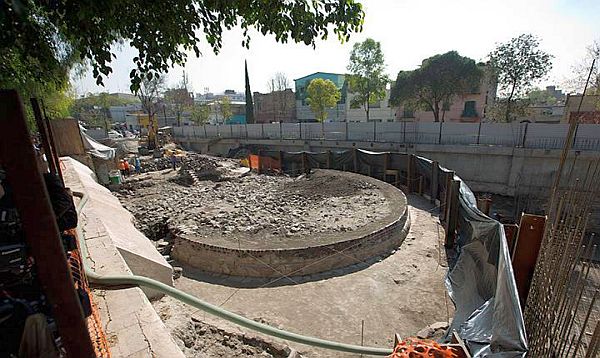Archaeologists this week announced the discovery of a pre-Columbian temple in central Mexico City believed to have been built for Ehecatl-Quetzalcoatl, the god of wind.
More than 650 years old, the temple was discovered during excavation work under a demolished mid-20th-century supermarket that sits meters away from a commercial plaza under construction, researchers said Wednesday.
During the initial excavation, archaeologists discovered a total of 43,000 objects, including 1,000 complete works.
But deeper down they were surprised to find the temple, which offers another example of how the Mexica-Tlatelolca people worshipped one of their principal deities. Offerings found at the site comprised ceramic figures of monkeys, bird bones and even an infant with no signs of trauma.
The circular platform, approximately 36 feet (11 meters) in diameter and four feet (1.2 meters) tall, had been built in the pre-Hispanic city of Tlatelolco, an economic rival to the nearby political power of Tenochtitlan.
The majority of the temple's original white stucco remains intact, and the plans are to preserve it and make it visible to the public with a large viewing window.
"The structure is very important because it was part of the sacred area of Tlatelolco," said Pedro Francisco Sanchez Nava, national archaeology coordinator for Mexico's National Anthropology and History Institute. "It shows how one of the deities of the Mexica-Tlatelolca pantheon was represented in this space," he added.
Eduardo Matos Moctezuma, researcher emeritus, said modern-day Mexico City covers several different pre-Hispanic cities, including Tlatelolco and its rival Tenochtitlan.
Tenochtitlan was a center of political power while Tlatelolco dedicated itself to commerce, with an important market that was noted even by the Spanish conquistador Hernán Cortes. Eventually Tenochtitlan took control of Tlatelolco.
When the Spanish and their indigenous allies began conquering Tenochtitlan, residents of that city withdrew to Tlatelolco to continue the fight and Tlatelolco became the last site of resistance against the Spanish in the area.
The temple is a "glimpse into the past, a place that opens up for us, from the archeological side, to understand the development of the cities that preceded us," Nava said.
Sources: ABC News • The Guardian • Deutsche Welle


